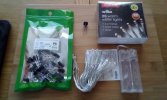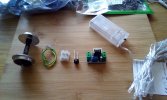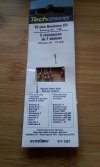ebay mike
Retired, but still hoarding. (GOF)
Being close to finishing my bar car for the smaller Orient Express rake my thoughts turned to interior lighting. Last Chxxxxxas I bought these lighting sets in Wilko's post festive sale. They were 25p rack (90% off!!!) so I bought 'a few', as you do. Worth it just for the two heavy duty AA batteries included. I want these to be track powered and have fitted the bogies with pick-up axles. The packaging states rated voltage is 3v and normal bulb rating 20 x 3.2v/0.064w. As these are obviously LEDs they require a DC input. Harking back to my days of Physics O level tells me a bridge rectifier is required. An Amazon purchase has produced a bag of said items. The packet says V(RRM):1000V & I(AV):2A. I am assuming these are the maximum loads and these will work in this scenario. I would like to feed the lighting chains via these rectifiers but need to know what value resistors have to be incorporated into the circuit. There are NO other components in the battery box other than an on/off switch. Would the resistor used be able to cope with the different track current input for either analog or DCC? I have a large bag of resistors put would appreciate any solution to include the band colour code so I can find the right one a little easier.
I also bought a box full of smaller chains from Poundland at 5p each, but these will remain battery operated as the PIKO coaches have plastic wheelsets.
Thanks.

I also bought a box full of smaller chains from Poundland at 5p each, but these will remain battery operated as the PIKO coaches have plastic wheelsets.
Thanks.





